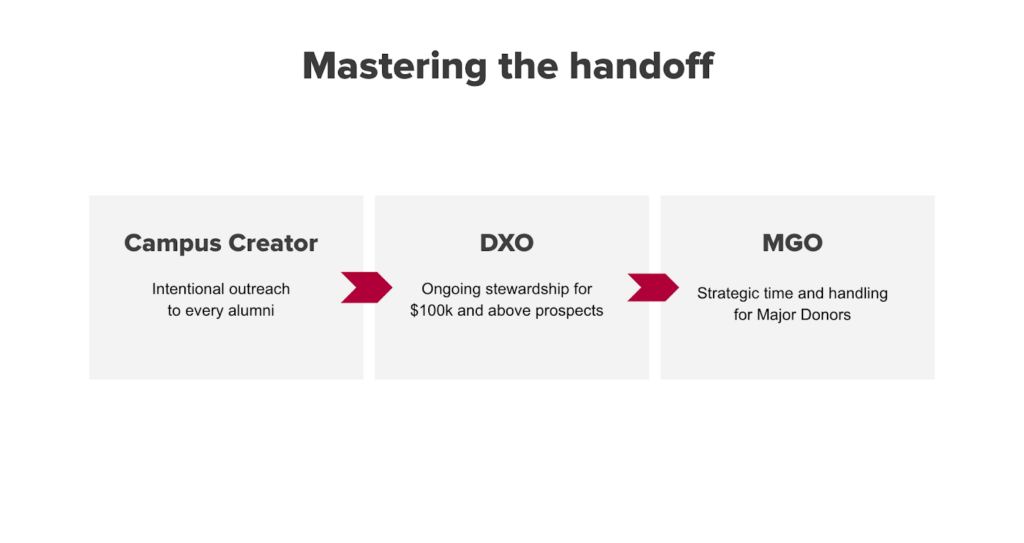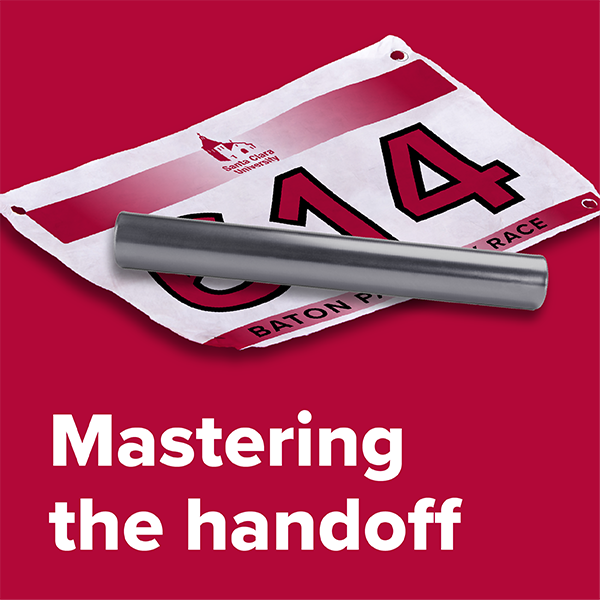The Santa Clara University teamed up with EverTrue to implement a Donor Experience (DX) program that would bridge the gap between annual giving donors and major gift prospects and propel prospect pipeline. Soon after launching a DX program, they swapped their phonathon program for a Campus Creators program. Here’s what they learned.
In many ways, Donor Engagement is like running a relay race. Sometimes it’s a full-out sprint to a fundraising deadline. There are often hurdles to overcome (data woes, process breakdowns), and you need strong momentum to get beyond them. And, ultimately, success is all about building a team to pass the baton and bring an alum from “long-overlooked” to “loyal lifetime supporter.”
Two years ago, the Santa Clara University advancement team faced an all-too-common problem. They had tons of alums, and only 2% of them had a 1:1 relationship with someone on the SCU team.
The team knew with that ratio, there was no way they could build the type of deep trust and engagement that would lead to big fundraising outcomes. So, they dove into the data, and here’s what they saw:
- 97.5% of constituents in their database were unassigned
- 20% of alumni were getting attention through reunions, but 80% were unengaged on an annual basis
- Leadership Gift Officers felt they weren’t getting the traction or bringing in the dollars they’d hoped
In short, tons of untapped potential.
As with all advancement shops, when the pandemic hit, there was an opportunity to look more closely at the SCU team structure. Suddenly, reliance on a good tech suite became a necessity, not a luxury. Gift officers realized they could close gifts remotely. And personalized, mass communications became a key part of SCU staying connected with the community during times of crisis.
The SCU team decided to lean into the “new normal,” and teamed up with EverTrue to launch a Donor Experience program, which operated on a few main tenets:
- Strategy and mindset borrowed from the world of high-velocity sales outreach
- A good tech stack that hugely scales 1:1 outreach
- A “startup” mindset
At a glance: FY21 vs FY23
First: Launching a Donor Experience program
Created in partnership with EverTrue, a Donor Experience program takes frontline fundraising and strips out its inefficiencies.
We partner with institutions to recruit, hire, and train tech-enabled fundraisers. We search the database for the 2-3 thousand next-best prospects who have been overlooked for a long time. (Like the alums who have been giving for ten years but have never received a phone call. Alums who met with a gift officer five years ago and never got a follow-up. Alums who just landed a C-suite position but haven’t been contacted since graduation.)
With a newly-assigned portfolio of 1,000 donors just teeming with potential, we partner with institutions to train new fundraisers (“Donor Experience Officers”) with a tech suite that takes the manual guesswork out of relationship building.
DXOs follow an EverTrue-prescribed outreach cadence to make sure that none of their assigned donors slip through the cracks. They reach out to 25 new donors each week. They hold an average of 56% more donor meetings than a traditional gift officer. And they raise 40% more revenue from their assigned portfolios, year over year.
Here’s a snapshot of the ROI Santa Clara has seen from their two DXOs.
Second: Launching a Campus Creators program
Next, the Santa Clara team took a close look at areas of big spending and assessed how they could shift resources to produce higher ROI, powered by great tech. The Santa Clara team had an incredible group of student callers, but phonathon programs are expensive and aren’t seeing great ROI, across the board.
In partnership with EverTrue, the Santa Clara team hired and trained student representatives to become the modern-day version of student callers, which we call Campus Creators. Campus Creators are student fundraisers who take a video-first approach to engaging with assigned portfolios of 3,000 donors, powered by a consistent content calendar.
In total, six Campus Creators at SCU are engaging about 16,000 donors through personalized video touchpoints. The early results of this switch from phonathon to Campus Creator program speak for themselves. Since the launch of the program at SCU, Campus Creators outreach produced…
- a 63% email open rate
- 539 upgraded annual donors
- 344 reactivated donors
The prospect handoff process
Establishing the Donor Experience program and then the Campus Creators program enabled the SCU team to implement a smooth structure to (finally!) master the prospect handoff pipeline and get more donors onto the major gift radar.
Here’s how this handoff process now looks:

1. Campus Creators at SCU are tasked with cultivating portfolios of 3,000 donors each. The donors in Campus Creators portfolios are SYBUNTS and high-capacity individuals who have not received personal outreach from SCU in many years – or ever.
Campus Creators send personalized videos to their donors each month, with content catered to the donors’ interests and recent engagement with SCU’s social media accounts. So far this year, Campus Creators have reached out to 15,000 SCU donors. Campus Creators track engagement and responses to these videos, and funnel engaged prospects and new donors onto the radars of Donor Experience Officers (DXOs).
2. Donor Experience Officers are tasked with cultivating portfolios of 1,000 donors each. Most of the donors in DXO portfolios show significant indications of wealth ($100K+ gift capacity), digital engagement, loyal giving patterns, or an historic inclination to give to SCU. Using the EverTrue tech suite, DXOs communicate with their portfolios through email, phone, social media, video, and virtual visits.
The team at SCU partners with EverTrue to determine the total quantity of donors to identify for elevation from Campus Creator outreach to a DXO portfolio. Utilizing wealth, giving history, and engagement data, the EverTrue team creates a curated list of the best prospects that fall within the elevation range. The SCU team reviews the list, provides feedback, and approves the list. EverTrue builds ThankView campaigns for Campus Creators to film personalized videos introducing each donor to their new point of contact (a DXO). Then, the DXO films a customized add-on video as an introduction, and DXOs promptly begin outreach to this specific group of donors.
In the first full year of hiring two DXOs, the team has increased donor meeting volume by 133%.
3. Major Gift Officers often partner with DXOs when a donor indicates intention and capacity to give at the major gift level. DXOs loop in MGOs when prospect conversations involve planned gifts, multi-year endowments, and longer-term gift conversations.
The level of engagement and responses to Campus Creators narrows down the donors who are ready to be elevated to a DXO, and then high-capacity prospects are funneled on to an MGO’s radar. One, two, three, prospect pipeline problem solved!
Lessons learned and takeaways
Through this new and intentional team structure and strategy, the Santa Clara team has created a prospect handoff process to engage long-overlooked donors; deliver a personalized, 1:1, authentic engagement experience; and have deeper conversations about impact and philanthropy with donors who indicate capacity and inclination.
Here are some lessons learned from launching Donor Experience and Campus Creators programs at Santa Clara:
- Launching a Donor Experience program scales 1:1 outreach throughout the donor pyramid (beyond just the top 2% of donors in MGO portfolios)
- Personalization is key for high-volume outreach, and that can only be accomplished with the help of good tech tools
- Through cadenced outreach and prescribed next steps, we can begin to rebuild relationships with disengaged donors
And here are some tips from the SCU team on where to begin:
- Create an org structure that works across the pyramid
- Personalize outreach
- Score leads
- Let technology work for you
- Create a prescriptive handoff process
- Be transparent. Change is hard!
Ready to establish a prospect handoff process at your institution? Get in touch!
